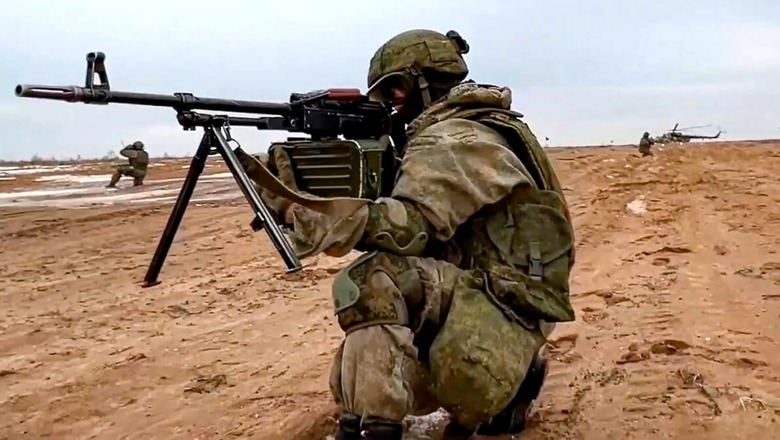
views
The Russian invasion of Ukraine last week shocked the world irrespective of its collective anticipation of a conflict. A superpower brought back in focus traditional kinetic wars amid the dominant military discourse on modern warfare.
Russian President Vladimir Putin had kept the strategic community guessing about his next move for weeks —as a steady buildup of troops and equipment at the Russia-Ukraine borders continued and Russia formally recognised the independence of Donetsk and Luhansk in eastern Ukraine’s Donbass area—before he dropped the bomb.
On Thursday, Putin ordered military operations on Ukraine, stating that he intends to “denazify” the country. In simple terms, this would go on to mean a full-fledged conventional war with Ukraine, as Russian troops would pour into the neighbouring country from the north, south and east –eventually broadening the assault from all directions—with columns of tanks and artillery guns. They would carry out airstrikes and fire hundreds of missiles to destroy dozens of Ukrainian military targets and civilian infrastructure while taking control of several Ukrainian territories and inching towards Kyiv.
As the stunned West scampered to impose a series of sanctions against Russia, Moscow continued with a typical traditional military assault with the deployment of land, air and sea forces, battling Ukrainian forces and resistance from civilians.
Russia’s kinetic assault on Ukraine comes at a time when much of the world’s modern militaries are researching, developing and investing on newer non-conventional forms of warfare involving unmanned aerial vehicles, cyberattacks, artificial intelligence, big data and quantum computing.
A 2020 research report by RAND Corporation—an American global policy think tank—had noted that China and Russia were pursuing artificial intelligence and other emerging technologies aggressively and noted that the future wars could well be “multidomain conflicts” fought with risks of nuclear escalation.
In India too, newer disruptive technologies are slowly getting to the centre stage of defence policies, military curriculum and long-term procurement plans.
Last year, the Army with support from the National Security Council Secretariat had set up a quantum computing laboratory and a centre for artificial intelligence (AI) at the Military College of Telecommunication Engineering, Mhow, to spearhead research and training in this sector.
In February this year, at the 13th Jumbo Majumdar International Seminar, Air Chief Marshal VR Chaudhari said that targeting critical information infrastructure and distributed denial of services have changed the way wars would manifest, and terrestrial, aerial and space-based systems being bound by a common network are also vulnerable to attacks.
“While traditional land, sea and aerial warfare will always take place, unconventional and hybrid means to disrupt conventional capability will need to be countered,” he had said in his speech.
The Russia-Ukraine conflict has shown that despite other emerging forms of warfare, a conventional assault is still the first and will perhaps remain the preferred choice of attack for years to come to achieve “conventional victory”.
Force multipliers
Several global military observers have called Russia’s assault a hybrid war—a mix of traditional and modern methods of warfare—a term also used earlier when Russia annexed Crimea from Ukraine in 2014.
Ukraine had indeed been inflicted with a series of damaging cyberattacks in the last few weeks, which caused multiple banks and government department websites to crash, according to a BBC report. The United States had alleged that they were orchestrated by Russia, which subsequently denied the claims.
Russia was also alleged to have engaged in spreading large-scale disinformation at this time, prompting Facebook and Twitter to remove such accounts connected to groups undertaking an anti-Ukrainian propaganda campaign, as per NBC News.
Undoubtedly, tactics such as cyberattacks and disinformation campaigns undertaken in a concerted way can cause serious damages to the security apparatus of an adversary, inside or outside a war. One example is that of a cyberattack reportedly carried out by Israel on Iran’s main nuclear facility at Natanz last year.
But in the latest instance, much less of it has been seen. They have only supplemented Russia’s conventional assault by acting as force multipliers, with their advantageous deniability factor.
What does this tell India?
The Indian Army, also the largest of the three defence services, continues to deploy about four lakh of its 13 lakh personnel in counterinsurgency (CI) and counterterrorism (CT) duties in the Northeast and in Jammu and Kashmir.
While Army Chief General MM Naravane had explicitly said that troops involved in CI roles are being gradually withdrawn from the Northeast, he had admitted that this may not be feasible in J&K anytime soon.
While tasking the troops with CI/CT operations had been prompted by closely calculated threat perceptions, this had also shifted away part of the Army’s focus from its core job of conventional warfighting.
The Russia-Ukraine war spotlights this aspect again for India, demanding a harder relook into this, also prompting the Army to realign its conventional warfare capabilities.
The war also brings to the forefront the absence of international military backing to Ukraine, undermining of several treaties signed and a nuclear threat by Putin when he asked the forces to be on alert—aspects warranting India’s urgent attention.
Secondly, the Army’s recruitments have seen major delays in the last two years, with the force citing the Covid-19 pandemic as the reason. This is bound to create a vacuum with a large number of experienced soldiers retiring every year and no influx of personnel who will also require adequate time to become operationally effective.
Fresh threat assessments in the backdrop of the Russia-Ukraine war and building capabilities based on them, but within shorter and fixed timeframes, are aspects India would be closely watching now.
The government’s campaign on atmanirbharta (self-reliance) in defence is a welcome step. After all, as seen with Russia, a militarily self-reliant country can not only attack or defend itself from aggression without any outside help but also keep its sophisticated weapons and equipment running for years.
It is, however, pertinent to emphasise that the campaign should not drown the immediate defence capability requirements for a conventional war.
Read all the Latest News India and Breaking News here


















Comments
0 comment